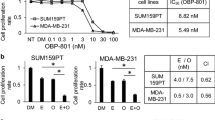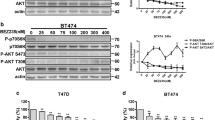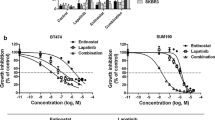Abstract
Purpose
Improved prognosis for triple-negative breast cancer (TNBC) has plateaued and the development of novel therapeutic strategies is required. This study aimed to explore the anti-tumor effect of combined eribulin and HDAC inhibitor (vorinostat: VOR, pan-HDAC inhibitor and ricolinostat: RICO, selective HDAC6 inhibitor) treatment for TNBC.
Methods
The effect of eribulin in combination with an HDAC inhibitor was tested in three TNBC cell lines (MDA-MB-231, Hs578T, and MDA-MB-157) and their eribulin-resistant derivatives. The expression of acetylated α-tubulin was analyzed by Western blotting for TNBC cells and immunohistochemical analyses for clinical specimens obtained from breast cancer patients who were treated with eribulin.
Results
The simultaneous administration of low concentrations (0.2 μM) of VOR or RICO enhanced the anti-tumor effect of eribulin in MDA-MB-231 and Hs578T cells but not in MDA-MB-157 cells. Meanwhile, pretreatment with 5 μM of VOR or RICO enhanced eribulin sensitivity in all three cell lines. Low concentration of VOR or RICO increased acetylated α-tubulin expression in MDA-MB-231 and Hs578T cells. In contrast, whereas 5 μM of VOR or RICO increased the expression of acetylated α-tubulin in MDA-MB-157 cells, low concentrations did not. Eribulin increased the expression of acetylated α-tubulin in MDA-MB-231 and Hs578T cells but not in MDA-MB-157 cells. These phenomena were also observed in eribulin-resistant cells. Immunohistochemical analyses revealed that the expression of acetylated α-tubulin was increased after eribulin treatment in TNBC.
Conclusions
HDAC6 inhibition enhances the anti-tumor effect of eribulin through the acetylation of α-tubulin. This combination therapy could represent a novel therapeutic strategy for TNBC.





Similar content being viewed by others
Data availability
The data supporting the findings of this work are available from the authors upon reasonable request.
Abbreviations
- EMT:
-
Epithelial–mesenchymal transition
- ER:
-
Estrogen receptor
- FEC:
-
5FU, epirubicin and cyclophosphamide
- HDAC:
-
Histone deacetylase
- MET:
-
Mesenchymal–epithelial transition
- PR:
-
Partial response
- RICO:
-
Ricolinostat
- siRNA:
-
Small interfering RNA
- TME:
-
Tumor microenvironment
- TNBC:
-
Triple-negative breast cancer
- VOR:
-
Vorinostat
References
Bonotto M, Gerratana L, Poletto E, Driol P, Giangreco M, Russo S, Minisini AM, Andreetta C, Mansutti M, Pisa FE, Fasola G, Puglisi F (2014) Measures of outcome in metastatic breast cancer: insights from a real-world scenario. Oncologist 19:608–615. https://doi.org/10.1634/theoncologist.2014-0002
den Brok WD, Speers CH, Gondara L, Baxter E, Tyldesley SK, Lohrisch CA (2017) Survival with metastatic breast cancer based on initial presentation, de novo versus relapsed. Breast Cancer Res Treat 161:549–556. https://doi.org/10.1007/s10549-016-4080-9
Montagna E, Maisonneuve P, Rotmensz N, Cancello G, Iorfida M, Balduzzi A, Galimberti V, Veronesi P, Luini A, Pruneri G, Bottiglieri L, Mastropasqua MG, Goldhirsch A, Viale G, Colleoni M (2013) Heterogeneity of triple-negative breast cancer: histologic subtyping to inform the outcome. Clin Breast Cancer 13:31–39. https://doi.org/10.1016/j.clbc.2012.09.002
Blows FM, Driver KE, Schmidt MK, Broeks A, van Leeuwen FE, Wesseling J, Cheang MC, Gelmon K, Nielsen TO, Blomqvist C, Heikkila P, Heikkinen T, Nevanlinna H, Akslen LA, Begin LR, Foulkes WD, Couch FJ, Wang X, Cafourek V, Olson JE, Baglietto L, Giles GG, Severi G, McLean CA, Southey MC, Rakha E, Green AR, Ellis IO, Sherman ME, Lissowska J, Anderson WF, Cox A, Cross SS, Reed MW, Provenzano E, Dawson SJ, Dunning AM, Humphreys M, Easton DF, Garcia-Closas M, Caldas C, Pharoah PD, Huntsman D (2010) Subtyping of breast cancer by immunohistochemistry to investigate a relationship between subtype and short and long term survival: a collaborative analysis of data for 10,159 cases from 12 studies. PLoS Med 7:e1000279. https://doi.org/10.1371/journal.pmed.1000279
Foulkes WD, Smith IE, Reis-Filho JS (2010) Triple-negative breast cancer. N Engl J Med 363:1938–1948. https://doi.org/10.1056/NEJMra1001389
Curtis C, Shah SP, Chin SF, Turashvili G, Rueda OM, Dunning MJ, Speed D, Lynch AG, Samarajiwa S, Yuan Y, Graf S, Ha G, Haffari G, Bashashati A, Russell R, McKinney S, Langerod A, Green A, Provenzano E, Wishart G, Pinder S, Watson P, Markowetz F, Murphy L, Ellis I, Purushotham A, Borresen-Dale AL, Brenton JD, Tavare S, Caldas C, Aparicio S (2012) The genomic and transcriptomic architecture of 2,000 breast tumours reveals novel subgroups. Nature 486:346–352. https://doi.org/10.1038/nature10983
Jordan MA, Kamath K, Manna T, Okouneva T, Miller HP, Davis C, Littlefield BA, Wilson L (2005) The primary antimitotic mechanism of action of the synthetic halichondrin E7389 is suppression of microtubule growth. Mol Cancer Ther 4:1086–1095. https://doi.org/10.1158/1535-7163.Mct-04-0345
Liu J, Towle MJ, Cheng H, Saxton P, Reardon C, Wu J, Murphy EA, Kuznetsov G, Johannes CW, Tremblay MR, Zhao H, Pesant M, Fang FG, Vermeulen MW, Gallagher BM Jr, Littlefield BA (2007) In vitro and in vivo anticancer activities of synthetic (-)-laulimalide, a marine natural product microtubule stabilizing agent. Anticancer Res 27:1509–1518
Tsuji T, Ibaragi S, Hu GF (2009) Epithelial-mesenchymal transition and cell cooperativity in metastasis. Cancer Res 69:7135–7139. https://doi.org/10.1158/0008-5472.Can-09-1618
Yoshida T, Ozawa Y, Kimura T, Sato Y, Kuznetsov G, Xu S, Uesugi M, Agoulnik S, Taylor N, Funahashi Y, Matsui J (2014) Eribulin mesilate suppresses experimental metastasis of breast cancer cells by reversing phenotype from epithelial-mesenchymal transition (EMT) to mesenchymal-epithelial transition (MET) states. Br J Cancer 110:1497–1505. https://doi.org/10.1038/bjc.2014.80
Bhola NE, Balko JM, Dugger TC, Kuba MG, Sanchez V, Sanders M, Stanford J, Cook RS, Arteaga CL (2013) TGF-beta inhibition enhances chemotherapy action against triple-negative breast cancer. J Clin Invest 123:1348–1358. https://doi.org/10.1172/jci65416
Kajiyama H, Shibata K, Terauchi M, Yamashita M, Ino K, Nawa A, Kikkawa F (2007) Chemoresistance to paclitaxel induces epithelial-mesenchymal transition and enhances metastatic potential for epithelial ovarian carcinoma cells. Int J Oncol 31:277–283
Oba T, Ito KI (2018) Combination of two anti-tubulin agents, eribulin and paclitaxel, enhances anti-tumor effects on triple-negative breast cancer through mesenchymal-epithelial transition. Oncotarget 9(33):22986–23002. https://doi.org/10.18632/oncotarget.25184
Funahashi Y, Okamoto K, Adachi Y, Semba T, Uesugi M, Ozawa Y, Tohyama O, Uehara T, Kimura T, Watanabe H, Asano M, Kawano S, Tizon X, McCracken PJ, Matsui J, Aoshima K, Nomoto K, Oda Y (2014) Eribulin mesylate reduces tumor microenvironment abnormality by vascular remodeling in preclinical human breast cancer models. Cancer Sci 105:1334–1342. https://doi.org/10.1111/cas.12488
Goto W, Kashiwagi S, Asano Y, Takada K, Morisaki T, Fujita H, Takashima T, Ohsawa M, Hirakawa K, Ohira M (2018) Eribulin Promotes Antitumor Immune Responses in Patients with Locally Advanced or Metastatic Breast Cancer. Anticancer Res. 38:2929–2938. https://doi.org/10.21873/anticanres.12541
Mitchison T, Kirschner M (1984) Dynamic instability of microtubule growth. Nature 312:237–242
Asthana J, Kapoor S, Mohan R, Panda D (2013) Inhibition of HDAC6 deacetylase activity increases its binding with microtubules and suppresses microtubule dynamic instability in MCF-7 cells. J Biol Chem 288:22516–22526. https://doi.org/10.1074/jbc.M113.489328
Song Y, Brady ST (2015) Post-translational modifications of tubulin: pathways to functional diversity of microtubules. Trends Cell Biol 25:125–136. https://doi.org/10.1016/j.tcb.2014.10.004
Hubbert C, Guardiola A, Shao R, Kawaguchi Y, Ito A, Nixon A, Yoshida M, Wang XF, Yao TP (2002) HDAC6 is a microtubule-associated deacetylase. Nature 417:455–458. https://doi.org/10.1038/417455a
Mehnert JM, Kelly WK (2007) Histone deacetylase inhibitors: biology and mechanism of action. Cancer J 13:23–29. https://doi.org/10.1097/PPO.0b013e31803c72ba
Richon VM, Garcia-Vargas J, Hardwick JS (2009) Development of vorinostat: current applications and future perspectives for cancer therapy. Cancer Lett 280:201–210. https://doi.org/10.1016/j.canlet.2009.01.002
Duvic M, Olsen EA, Breneman D, Pacheco TR, Parker S, Vonderheid EC, Abuav R, Ricker JL, Rizvi S, Chen C, Boileau K, Gunchenko A, Sanz-Rodriguez C, Geskin LJ (2009) Evaluation of the long-term tolerability and clinical benefit of vorinostat in patients with advanced cutaneous T-cell lymphoma. Clin Lymphoma Myeloma 9:412–416. https://doi.org/10.3816/CLM.2009.n.082
Cosenza M, Civallero M, Marcheselli L, Sacchi S, Pozzi S (2017) Ricolinostat, a selective HDAC6 inhibitor, shows anti-lymphoma cell activity alone and in combination with bendamustine. Apoptosis 22:827–840. https://doi.org/10.1007/s10495-017-1364-4
Vogl DT, Raje N, Jagannath S, Richardson P, Hari P, Orlowski R, Supko JG, Tamang D, Yang M, Jones SS, Wheeler C, Markelewicz RJ, Lonial S (2017) Ricolinostat, the First Selective Histone Deacetylase 6 Inhibitor, in Combination with Bortezomib and Dexamethasone for Relapsed or Refractory Multiple Myeloma. Clin Cancer Res 23:3307–3315. https://doi.org/10.1158/1078-0432.ccr-16-2526
Peng U, Wang Z, Pei S, Ou Y, Hu P, Liu W, Song J (2017) ACY-1215 accelerates vemurafenib induced cell death of BRAF-mutant melanoma cells via induction of ER stress and inhibition of ERK activation. Oncol Rep 37:1270–1276. https://doi.org/10.3892/or.2016.5340
Catalano MG, Poli R, Pugliese M, Fortunati N, Boccuzzi G (2007) Valproic acid enhances tubulin acetylation and apoptotic activity of paclitaxel on anaplastic thyroid cancer cell lines. Endocr Relat Cancer 14:839–845. https://doi.org/10.1677/erc-07-0096
Owonikoko TK, Ramalingam SS, Kanterewicz B, Balius TE, Belani CP, Hershberger PA (2010) Vorinostat increases carboplatin and paclitaxel activity in non-small-cell lung cancer cells. Int J Cancer 126:743–755. https://doi.org/10.1002/ijc.24759
Dowdy SC, Jiang S, Zhou XC, Hou X, Jin F, Podratz KC, Jiang SW (2006) Histone deacetylase inhibitors and paclitaxel cause synergistic effects on apoptosis and microtubule stabilization in papillary serous endometrial cancer cells. Mol Cancer Ther 5:2767–2776. https://doi.org/10.1158/1535-7163.Mct-06-0209
Zuco V, De Cesare M, Cincinelli R, Nannei R, Pisano C, Zaffaroni N, Zunino F (2011) Synergistic antitumor effects of novel HDAC inhibitors and paclitaxel in vitro and in vivo. PLoS ONE 6:e29085. https://doi.org/10.1371/journal.pone.0029085
Ono H, Sowa Y, Horinaka M, Iizumi Y, Watanabe M, Morita M, Nishimoto E, Taguchi T, Sakai T (2018) The histone deacetylase inhibitor OBP-801 and eribulin synergistically inhibit the growth of triple-negative breast cancer cells with the suppression of survivin, Bcl-xL, and the MAPK pathway. Breast Cancer Res Treat 171:43–52. https://doi.org/10.1007/s10549-018-4815-x
Oba T, Izumi H, Ito KI (2016) ABCB1 and ABCC11 confer resistance to eribulin in breast cancer cell lines. Oncotarget 7(43):70011–70027. https://doi.org/10.18632/oncotarget.11727
Kano Y, Ohnuma T, Okano T, Holland JF (1988) Effects of vincristine in combination with methotrexate and other antitumor agents in human acute lymphoblastic leukemia cells in culture. Cancer Res 48:351–356
Fujita T, Ito K, Izumi H, Kimura M, Sano M, Nakagomi H, Maeno K, Hama Y, Shingu K, Tsuchiya S, Kohno K, Fujimori M (2005) Increased nuclear localization of transcription factor Y-box binding protein 1 accompanied by up-regulation of P-glycoprotein in breast cancer pretreated with paclitaxel. Clin Cancer Res 11:8837–8844. https://doi.org/10.1158/1078-0432.ccr-05-0945
Putcha P, Yu J, Rodriguez-Barrueco R, Saucedo-Cuevas L, Villagrasa P, Murga-Penas E, Quayle SN, Yang M, Castro V, Llobet-Navas D, Birnbaum D, Finetti P, Woodward WA, Bertucci F, Alpaugh ML, Califano A, Silva J (2015) HDAC6 activity is a non-oncogene addiction hub for inflammatory breast cancers. Breast Cancer Res 17:149. https://doi.org/10.1186/s13058-015-0658-0
Westermann S, Weber K (2003) Post-translational modifications regulate microtubule function. Nat Rev Mol Cell Biol 4:938–947. https://doi.org/10.1038/nrm1260
Torres-Adorno AM, Lee J, Kogawa T, Ordentlich P, Tripathy D, Lim B, Ueno NT (2017) Histone Deacetylase Inhibitor Enhances the Efficacy of MEK Inhibitor through NOXA-Mediated MCL1 Degradation in Triple-Negative and Inflammatory Breast Cancer. Clin Cancer Res 23:4780–4792. https://doi.org/10.1158/1078-0432.Ccr-16-2622
Huang P, Almeciga-Pinto I, Jarpe M, van Duzer JH, Mazitschek R, Yang M, Jones SS, Quayle SN (2017) Selective HDAC inhibition by ACY-241 enhances the activity of paclitaxel in solid tumor models. Oncotarget 8(2):2694–2707. https://doi.org/10.18632/oncotarget.13738
Azuma K, Urano T, Horie-Inoue K, Hayashi S, Sakai R, Ouchi Y, Inoue S (2009) Association of estrogen receptor alpha and histone deacetylase 6 causes rapid deacetylation of tubulin in breast cancer cells. Cancer Res 69:2935–2940. https://doi.org/10.1158/0008-5472.Can-08-3458
Boggs AE, Vitolo MI, Whipple RA, Charpentier MS, Goloubeva OG, Ioffe OB, Tuttle KC, Slovic J, Lu Y, Mills GB, Martin SS (2015) alpha-Tubulin acetylation elevated in metastatic and basal-like breast cancer cells promotes microtentacle formation, adhesion, and invasive migration. Cancer Res 75:203–215. https://doi.org/10.1158/0008-5472.Can-13-3563
Xiao H, Verdier-Pinard P, Fernandez-Fuentes N, Burd B, Angeletti R, Fiser A, Horwitz SB, Orr GA (2006) Insights into the mechanism of microtubule stabilization by Taxol. Proc Natl Acad Sci U S A 103:10166–10173. https://doi.org/10.1073/pnas.0603704103
Jain S, Vahdat LT (2011) Eribulin mesylate. Clin Cancer Res 17:6615–6622. https://doi.org/10.1158/1078-0432.Ccr-11-1807
Klein I, Sarkadi B, Varadi A (1999) An inventory of the human ABC proteins. Biochim Biophys Acta 1461:237–262
Fan YF, Zhang W, Zeng L, Lei ZN, Cai CY, Gupta P, Yang DH, Cui Q, Qin ZD, Chen ZS, Trombetta LD (2018) Dacomitinib antagonizes multidrug resistance (MDR) in cancer cells by inhibiting the efflux activity of ABCB1 and ABCG2 transporters. Cancer Lett 421:186–198. https://doi.org/10.1016/j.canlet.2018.01.021
Li J, Kumar P, Anreddy N, Zhang YK, Wang YJ, Chen Y, Talele TT, Gupta K, Trombetta LD, Chen ZS (2017) Quizartinib (AC220) reverses ABCG2-mediated multidrug resistance: In vitro and in vivo studies. Oncotarget 8(55):93785–93799. https://doi.org/10.18632/oncotarget.21078
Nickerson NN, Jao CC, Xu Y, Quinn J, Skippington E, Alexander MK, Miu A, Skelton N, Hankins JV, Lopez MS, Koth CM, Rutherford S, Nishiyama M (2018) A Novel Inhibitor of the LolCDE ABC Transporter Essential for Lipoprotein Trafficking in Gram-Negative Bacteria. Antimicrob Agents Chemother. https://doi.org/10.1128/aac.02151-17
Acknowledgement
We would like to thank Editage (www.editage.com) for English language editing.
Funding
This work was supported by Grants-in-aid for Scientific Research (#17K10541) from the Japanese Society for the Promotion of Science.
Author information
Authors and Affiliations
Contributions
TO and KI contributed to the conception and design of the experiments, data analysis, and interpretation and drafted the manuscript. TO, MO, and YH performed the experiments and contributed to the acquisition of data. MH and TU evaluated the IHC staining of acetylated α-tubulin. All authors read and approved the final manuscript.
Corresponding author
Ethics declarations
Conflicts of interest
The authors declare that they have no competing interests.
Ethical approval
This study was approved by the Medical Ethics Committee on Clinical Investigation of Shinshu University (No. 3819). All procedures performed in studies involving human participants were in accordance with the 1964 Helsinki declaration and its later amendments or comparable ethical standards.
Consent to participate
Written informed consent was obtained from all patients.
Consent for publication
Not applicable.
Additional information
Publisher's Note
Springer Nature remains neutral with regard to jurisdictional claims in published maps and institutional affiliations.
Supplementary Information
Below is the link to the electronic supplementary material.
Rights and permissions
About this article
Cite this article
Oba, T., Ono, M., Matoba, H. et al. HDAC6 inhibition enhances the anti-tumor effect of eribulin through tubulin acetylation in triple-negative breast cancer cells. Breast Cancer Res Treat 186, 37–51 (2021). https://doi.org/10.1007/s10549-020-06033-2
Received:
Accepted:
Published:
Issue Date:
DOI: https://doi.org/10.1007/s10549-020-06033-2




